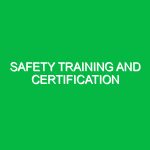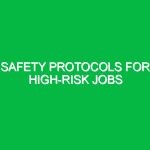In today’s dynamic landscape, the importance of Emergency Response Planning (ERP) cannot be overstated. Emergencies, whether they are natural disasters, industrial accidents, or unforeseen health crises, can strike at any moment. When they do, having a robust ERP in place can mean the difference between chaos and effective management. This article delves into the intricacies of Emergency Response Planning, its relevance in the Health, Safety, and Environment (HSE) domain, and provides actionable insights for creating a comprehensive ERP framework.
Understanding Emergency Response Planning
Emergency Response Planning refers to the systematic approach of preparing for, responding to, and recovering from emergencies. It encompasses a variety of strategies designed to minimize risks, protect lives, and safeguard property. In the HSE context, ERP focuses on ensuring that organizations have the necessary protocols in place to manage potential hazards effectively. This planning is not merely a regulatory requirement; it is an ethical obligation to protect employees, stakeholders, and the environment.
The relevance of ERP in HSE is multifaceted. Firstly, it enhances workplace safety by identifying potential risks and establishing protocols for addressing them. Secondly, it fosters a culture of preparedness among employees, empowering them to act decisively in emergency situations. Lastly, effective ERP can mitigate financial losses and legal repercussions, which can arise from poorly managed emergencies.
Identifying Hazards and Risks
Before initiating an Emergency Response Plan, it is essential to identify potential hazards and risks that an organization may face. These can be broadly categorized into natural, technological, and human-made hazards.
Natural Hazards
Natural hazards include events such as earthquakes, floods, hurricanes, and wildfires. For instance, consider a manufacturing plant located in a flood-prone area. The ERP for such a facility must account for the risk of flooding and include measures such as elevating critical infrastructure and creating evacuation routes.
Technological Hazards
Technological hazards often arise from the use of machinery, chemicals, or electricity. A classic example is a chemical spill in a laboratory setting. The ERP should include immediate containment procedures, evacuation routes, and a communication plan for informing relevant authorities. According to a case study published in the Journal of Occupational Health and Safety, proper training and drills significantly reduced the response time during a chemical spill incident.
Human-Made Hazards
Human-made hazards can stem from workplace violence, terrorism, or negligence. An example of this can be seen in the 2013 Boston Marathon bombing, which highlighted the need for comprehensive emergency response plans in public events. Organizations must assess their vulnerabilities and develop tailored responses to such threats.
Safety Precautions and Best Practices
Once potential hazards have been identified, the next step is to implement safety precautions and best practices. Here are several key considerations for effective Emergency Response Planning:
1. Conduct Risk Assessments
Risk assessments are critical in identifying vulnerabilities within the organization. They should be conducted regularly and updated as new risks emerge. Involve employees in this process, as they can provide valuable insights into potential hazards they encounter daily.
2. Develop Comprehensive Plans
Emergency Response Plans should be detailed and include specific procedures for various scenarios. This includes communication protocols, evacuation routes, and roles and responsibilities. For instance, a plan might outline that the safety officer is responsible for coordinating evacuations during a fire alarm.
3. Train Employees
Training is paramount. Employees should understand their roles in an emergency, the location of exits, and the use of emergency equipment such as fire extinguishers. Regular drills help reinforce knowledge and build confidence. According to a study by the National Safety Council, organizations that conduct regular emergency drills see a 50% decrease in response time during real incidents.
4. Maintain Emergency Supplies
Having the right supplies on hand is crucial. First-aid kits, fire extinguishers, and emergency food and water should be easily accessible. Regularly check and replenish these supplies to ensure they are up-to-date. In one instance, a construction site that maintained an emergency supply kit was able to provide immediate assistance when a worker sustained an injury, significantly improving recovery outcomes.
Regulations and Standards Governing Emergency Response Planning
Compliance with regulations and standards is essential for effective Emergency Response Planning. Various organizations and government bodies set guidelines to ensure safety in the workplace. Here are some key regulations to be aware of:
1. Occupational Safety and Health Administration (OSHA)
OSHA provides regulations that require employers to have Emergency Action Plans (EAPs). These plans should outline how to respond to different types of emergencies, ensuring the safety of employees and visitors. OSHA mandates that EAPs be communicated to all employees and that they receive training on these procedures.
2. National Fire Protection Association (NFPA)
The NFPA establishes codes and standards aimed at reducing the risk of fire-related incidents. NFPA 1600, for instance, provides a framework for emergency management and business continuity. Adhering to these standards is crucial for organizations that deal with flammable materials or operate in high-risk environments.
3. Federal Emergency Management Agency (FEMA)
FEMA offers resources for creating effective emergency management plans. Their guidelines emphasize community involvement and the need for organizations to collaborate with local emergency services. Engaging with FEMA can also help organizations secure funding for emergency preparedness initiatives.
Conclusion
Emergency Response Planning is an integral part of the Health, Safety, and Environment domain. By understanding potential hazards, implementing safety precautions, and adhering to regulatory standards, organizations can create effective ERPs that protect employees and minimize risks. The proactive approach of planning not only enhances workplace safety but also fosters a culture of preparedness that can save lives and resources. In a world where emergencies are inevitable, being prepared is not just an option; it’s a necessity.


